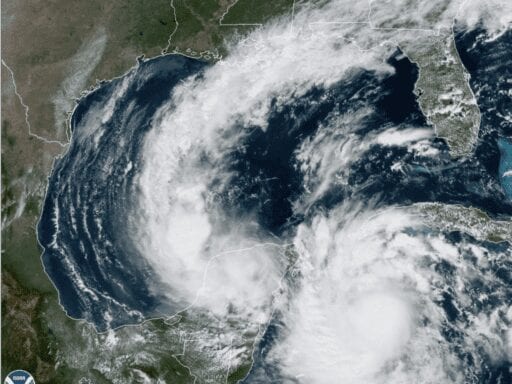The Category 4 storm is projected to be “extremely dangerous” when it makes landfall near Cancun, Mexico.
Hurricane Delta, the latest storm in this year’s “hyperactive” Atlantic hurricane season, is poised to make a destructive landfall on the Yucatan Peninsula late Tuesday or early Wednesday before continuing north toward Louisiana and Mississippi.
The storm is expected to be strongest when it hits the Yucatan Peninsula, but the risk to the US is also growing. “There is an increasing likelihood of life-threatening storm surge and hurricane-force winds, especially along the coasts of Louisiana and Mississippi, beginning on Friday,” the National Hurricane Center said.
Over the past day and a half, the storm morphed from a mere tropical depression (indicating wind speeds less than 38 mph) to a Category 4 hurricane— a record-setting intensification, according to Samuel Lillo, a postdoctoral meteorologist at the University of Colorado Boulder
Delta just went from 35mph tropical depression to 130mph category 4 hurricane in 30 hours!
I can’t find any other storm on record in the Atlantic that has achieved this feat.
The next largest 30-hour intensification from tropical depression is Celia 1970: 35mph to 115mph.
— Sam Lillo (@splillo) October 6, 2020
Climate change has increased the frequency and intensity of Atlantic hurricanes, and rapidly intensifying hurricanes like Delta are becoming more common due to climate change as well.
As of Tuesday evening, Delta had reached maximum sustained winds of 145 mph as it barreled through the Caribbean Sea, and it is expected to grow stronger. Current projections from the National Hurricane Center show it making landfall near Cancun, Mexico, late Tuesday or early Wednesday morning as an “extremely dangerous hurricane.”
The storm has at least a 30 percent chance of growing into the strongest type of hurricane, Category 5 (with wind speeds in excess of 156 miles per hour) by the time it reaches land, according to meteorologist Jeff Masters.
/cdn.vox-cdn.com/uploads/chorus_asset/file/21941793/Screen_Shot_2020_10_06_at_6.58.58_PM.png) National Hurricane Center
National Hurricane CenterHow much physical destruction the storm causes will depend on whether it directly hits the tourist hot spot Cancun, in which case it could be a multibillion-dollar disaster. The government ordered evacuations on Tuesday morning, and tens of thousands of tourists will have to relocate to shelters.
After moving through the Yucatan, the storm is projected to travel up the Gulf of Mexico and make landfall again on the US Gulf Coast on Friday. Where exactly Delta might land remains uncertain, but the current trajectory shows it primarily hitting Louisiana as a Category 2 storm. It could also impact Mississippi, Alabama, and the Florida panhandle, and could bring 4 to 8 inches of rain, even up to 12 inches in some places.
These states are still rebounding from the impact of Hurricane Laura and Hurricane Sally over the past two months.
Though its brush with the Yucatan will slow the storm, it is expected to pick up speed again.
“Although some weakening is likely when Delta moves over the Yucatan peninsula, re-strengthening is forecast when the hurricane moves over the southern Gulf of Mexico,” according to the National Hurricane Center briefing on Tuesday afternoon.
As Vox’s Brian Resnick explained, forecasts for a hurricane’s trajectory, particularly beyond the immediate 24 hours. are more prone to uncertainty, and forecasting storm intensity is particularly difficult. But Gulf Coast residents should prepare for another major storm in line with the latest National Hurricane Center projections.
How to follow Delta:
- The National Hurricane Center has a page updating every few hours with the latest watches and warnings for Delta. Check it out.
- Here’s a Twitter list of weather experts who will provide up-to-the-second forecasts and warnings.
Millions turn to Vox each month to understand what’s happening in the news, from the coronavirus crisis to a racial reckoning to what is, quite possibly, the most consequential presidential election of our lifetimes. Our mission has never been more vital than it is in this moment: to empower you through understanding. But our distinctive brand of explanatory journalism takes resources. Even when the economy and the news advertising market recovers, your support will be a critical part of sustaining our resource-intensive work. If you have already contributed, thank you. If you haven’t, please consider helping everyone make sense of an increasingly chaotic world: Contribute today from as little as $3.
Author: Lili Pike
Read More



